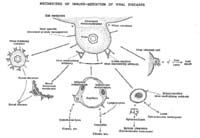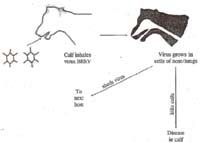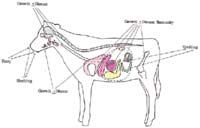Transmission and pathogenesis of viral infections: The key to developing control programs (Proceedings)
Direct transmission requires that animals be in close, intimate contact because the animal-free state of the virus must be very short in order to effect a successful transmission of viable virus.
Transmission of Viruses
Direct Transmission
Direct transmission requires that animals be in close, intimate contact because the animal-free state of the virus must be very short in order to effect a successful transmission of viable virus. Direct transmission of viral infections can be controlled by isolation of infected animals and by immunization of susceptible individuals. The mechanisms for direct transmission of viruses are via aerosol, direct contact, and sexual transmission; it is difficult to separate aerosol transmission clearly from direct contact.
Generally, viruses that are transmitted via aerosol are more stable viruses and are able to survive for longer periods of time outside of the host's bodily environment; conversely, viruses that are transmitted by direct intimate contact or sexually are more unstable and require rapid and immediate transmission in order to maintain their viability (infectivity). Enveloped viruses generally require close direct contact, or arthropod vectors, to effect transmission.
Vector Transmission
Vectors serve as intermediaries between the infected and the susceptible animals. Vectors are either biological or mechanical. Requisite for insect vector transmission is a high level viremia in the infected mammalian animal, without which the vector would be less likely to be infected during a blood meal on an infected animal.
Biological Vectors. Biological vectors support the replication of the virus, with concomitant amplification, before transmission to the new host. Bluetongue virus is transmitted by a biological insect vector. Vector control is, however, the single most important preventative measure.
Mechanical Vectors. Two types of mechanical vectors are of concern: inanimate vectors (fomites) and animate vectors including ticks, flies and other animals. Animate (insect) vectors may also acquire a virus during a blood meal which is then transmitted to a new host without replication within the vector.
Control and management mechanisms applicable to mechanical vectors are generally those of hygiene and disinfection. Therefore, the clinician should be aware of the significance of single-use materials, i.e., syringes and needles, endo-tracheal tubes, palpation sleeves, and thorough disinfection of equipment between animals and premises. As with biological vectors, control of disease requires control and elimination of the vector(s).
Genetic (Vertical) Transmission
Genetic transmission occurs the least often of the mechanisms discussed but is of importance for oncornavirus, herpesvirus, and orbivirus infections. Genetic transmission is the transmission of virus from one generation to successive generation via the germ cell(s). Genetic transmission may occur by the simple attachment or association of an infectious virus or the viral genome to the germ cell. The genetic transmission of IBR and blue tongue viruses in semen has been demonstrated; these viruses have been shown to be absorbed to the sperm cell. Oncornavirus genome may be incorporated into the germ cell genome.
Pathogenesis of Viral Infections
Viral pathogenesis is a continuum of processes that begins with transmission and proceeds through clinical (or sub clinical) disease ending with recovery or death of the animal. Since viruses may be transmitted during replication at entry when clinical signs are not evident, an infection may spread among many susceptible individuals before the appearance of clinical cases. Viral pathogenesis is unique among infectious diseases because of the interaction of the agent and the host at the organ, cell and gene levels. Viral infections are characterized as acute, chronic, and persistent (the virus persists permanently or for prolonged periods of time within the host) and present as clinical, sub-clinical or asymptomatic diseases. Viral infections are generalized (involving many bodily systems and includes persistent infections) and localized (involving one bodily system).
Enveloped viruses have a unique component to the disease caused by these viruses. All enveloped viruses induce an immune mediated disease component during their infections. In some cases, the component is clinically manifest such as the ITP caused by BVD Type 2 virus or as in apparent vasculitis induced by BVD type 1.

Click image to enlarge
Localized viral infections are those with clinical signs manifest in, and related to, the replication of the infecting virus at the site of entry. There is no dissemination of virus to other organs. In uncomplicated localized viral infections, host responses to the infection are usually minimal in severity and consequence except TGE, corona etc. The responses usually consist of local manifestations of increased secretion, local inflammation, necrosis, etc. Unfortunately, localized viral infections are often complicated by secondary invaders which may result in the more generalized signs of fever, nausea, and vomiting.

Click image to enlarge
Since virus is not systemic in localized infection, control of the disease is by the stimulation of local interferon and the production of local or surface immunity. The incubation and duration of localized viral diseases is extremely short, unless complicated by secondary infections. Consequently, localized viral infections often appear as explosive outbreaks of disease. Vaccination programs are generally ineffective due to the short duration of immunity.
Generalized viral infections are those infections in which disease is evidenced by organ system failure distant from the portal of entry, but clinical signs of generalized infections may also manifest at the site of entry. Generalized viral infections are routinely characterized by a target organ, that is, the site at which clinical signs are manifest, therefore, IBR is a generalized respiratory infection with reproductive and/or respiratory disease.

Click image to enlarge
The schema for a generalized infection is: 1) entry of the virus, 2) primary replication (amplification) at the portal of entry, 3) primary viremia with dissemination of virus to organs such as liver and spleen, 4) secondary replication of virus within these latter organs, 5) secondary viremia with dissemination of virus to 6) the target organ(s). Development of clinical signs generally become evident during stage 4 and later.
In generalized viral infections, the virus is readily transmissible during replication at the site of entry and as well as during replication at the target organs; for example, in IBR, the virus may be in respiratory secretions during replication at the portal of entry (respiratory tract) and later may be present in respiratory secretions and abortuses during replication in the target organs (lungs, fetus).
Generalized viral infections routinely are accompanied by a febrile reaction; and in an uncomplicated infection, the fever is associated with vascular phases (viremia) of the infection. The febrile response during primary viremia often goes undetected whereas the secondary viremia is usually accompanied by a high fever. Generalized viral infections often result in similar clinical pictures because the host has only a limited number of responses (clinical symptomatology) associated with organ or system dysfunction.
Generalized viral infections routinely are accompanied by longer incubation periods and duration of disease. On the other hand, generalized infections are more amenable to prophylaxis by vaccination because humoral antibodies will limit primary and secondary viremias and the CMI response will limit cellular replication in the internal organs and the placenta.
Podcast CE: A Surgeon’s Perspective on Current Trends for the Management of Osteoarthritis, Part 1
May 17th 2024David L. Dycus, DVM, MS, CCRP, DACVS joins Adam Christman, DVM, MBA, to discuss a proactive approach to the diagnosis of osteoarthritis and the best tools for general practice.
Listen
Podcast CE: A Surgeon’s Perspective on Current Trends for the Management of Osteoarthritis, Part 1
May 17th 2024David L. Dycus, DVM, MS, CCRP, DACVS joins Adam Christman, DVM, MBA, to discuss a proactive approach to the diagnosis of osteoarthritis and the best tools for general practice.
Listen
2 Commerce Drive
Cranbury, NJ 08512
All rights reserved.